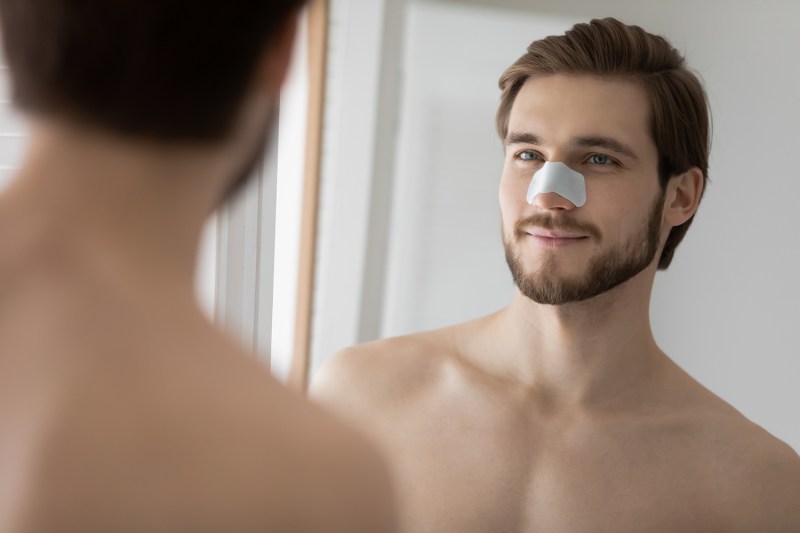
Since many of us are on video conference calls or even video calls with family, there’s nothing worse than seeing a blackhead standing sentinel on the plain of your well-groomed face. No matter how good the rest of you looks, the knowledge of that unsightly blemish will ruin your feelings every time you confront your reflection for the rest of the day.
Blackheads happen when excess oil from your skin (known as sebum) and dead skin cells collect in your skin’s pores, the tiny holes that allow your skin to “breathe.” Blackheads result from clogged pores with open surfaces, allowing for dark-colored oxidation that gives the blemish its name.
For most men, the battle with blackheads reaches its heady peak during the teenage years, when wildly fluctuating hormones cause your skin to flush with excess oil. But they can show up from time to time, even during your glory days, thanks to sweat, dirt, bacteria, poor diet, and even stress. Read on to learn how to get rid of blackheads and prevent them once and for all.
Treatment tips for blackheads

Try an oil-based cleanser
As crazy as it sounds, oil does dissolve oil, which is exactly what your blackhead-afflicted face needs. Jojoba oil has a chemical makeup almost identical to that of sebum, making it a great option for cleansing your pores without drying your skin. Rub a tablespoon or so of the oil into your face, leaving it on for 5-10 minutes, then steam it off with a hot, wet washcloth. Try it for a week — you might be surprised by how effective it is.
Exfoliate
But not too much. Together with excess sebum, dead skin cells are the principal cause of blocking your pores and creating the buildup that ends with a blackhead. However, don’t overdo the exfoliation — getting too zealous with the scrub or the skin brush will irritate your skin and (you guessed it) trigger an excess of sebum.
Try a clay mask
French green clay is a time-honored standby for soothing irritated skin while drawing out impurities. If you’ve never tried it, you’re in for a treat. The cool sensation of the mud on your skin is instantly relaxing, and the steamy towel you use to wipe it off is a great chaser. Here are some of the best face masks for men.
Rethink your diet
We didn’t want to have to say it, but … well, we’re saying it. Poor nutrition has been linked to dermatological breakouts, and we’re not just talking about greasy food, although that’s certainly a classic culprit. Processed foods, foods high in sugar or simple carbs, and even overindulgence in delicious amazing foods like craft beer and pasteurized pork belly cause your blood sugar to spike, which starts a chain reaction that leads to an overproduction of sebum. We’re not saying you can’t ever enjoy a plate of poutine or a heady slice of pizza again. Just ease off until your skin regulates.
Balance your hormones
Teenagers aren’t the only ones with hormone problems — hormones are equally susceptible to imbalance if your diet is messed up, you’re not getting enough sleep, or if you’re just really stressed out. By treating the underlying cause through improving your overall health or taking a natural adaptogen (i.e., hormone balancer) such as maca root or reishi mushroom, you might see a matching improvement in your skin.
How to prevent blackheads

Keep your skin clean
This is your first line of defense against blackheads. Find yourself a good, gentle soap or cleanser and use it every day. You can use a mild toner or even apple cider vinegar (never mind the smell) to expel dirt and guard against bacteria.
Avoid products that “tighten” or “minimize” pores
Don’t give in to the temptation of trying to close off your pores. That’s actually counterproductive (not to mention a practical impossibility). Pores are how your skin breathes. Trying to close them off or dry them out with alcohol-based skin treatments or benzoyl peroxide will only over-activate your sebaceous glands, leading to even worse breakouts. Maintaining lightly moisturized skin is the best way to moderate its oil output and keep blackheads at bay.
If you take preventative measures and follow up with appropriate treatment, your blackheads should dissolve quickly, along with the embarrassment you might be feeling for having one.
How to get rid of blackheads on nose areas

When it comes to learning how to get rid of blackheads on your nose, you can follow most of the tips for getting rid of blackheads on your face (the nose is a part of the face after all). But there are some things that you can do specifically to treat and prevent blackheads on your nose.
One of the best ways to treat blackheads on nose areas is with pore strips. The sticky strips attach to the blackheads, dry them out, and then remove them as you peel the strip off. However, there can be issues with pore strips. They need to be used carefully, or you can damage the skin on your nose. The best advice for using pore strips is to always follow the manufacturer’s instructions and never leave them on longer than the recommended time.


